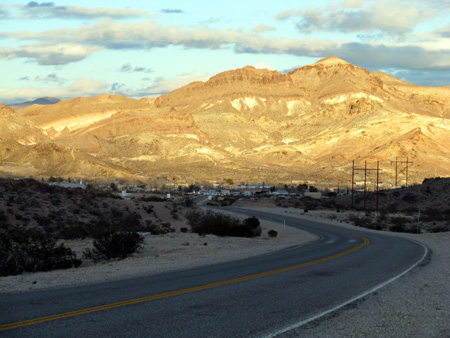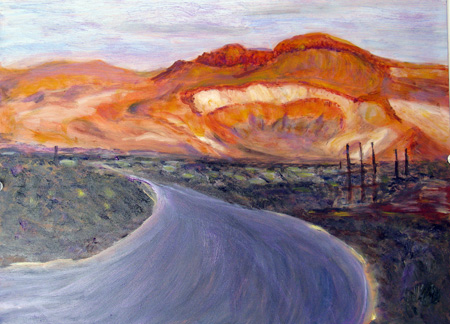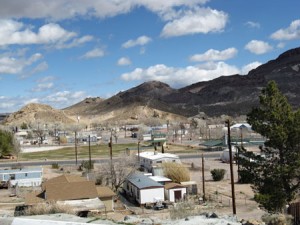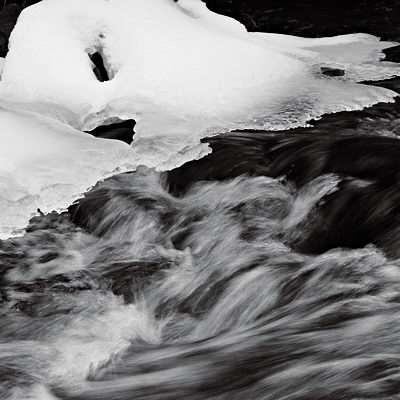Posted by Steve Durbin on April 27th, 2009
I drove through parts of Yellowstone a week ago, just a day after the Park (as it’s known locally) opened to automobiles. (I had been hoping to bike in the car-free weeks before that, as I normally do, but the weather was uncooperative.) Despite my regular visits, and posts to this blog, I realized I’ve never shown any photographs of the thermal features for which Yellowstone is justly famous. I have made a few before—surprisingly few—but somehow they never appealed much to me. For some reason I can’t put my finger on, this time felt different, and there are several images I’m willing to publish.

more… »
Posted by June Underwood on April 18th, 2009
As Steve noted not long ago, perception — how, as well as what, we see and record — is prime territory for this group. Some weeks ago I wrote about painting in the desert, the Great Basin to be more precise, and, even more specifically, the Amargosa Plain just outside of Death Valley.
After having spent 6 weeks in the desert, perceiving and painting, mostly plein air, I am now back in Portland reading about desert perception in William L. Fox’s The Void, the Grid, and the Sign.
Fox has spent most of his life in and around a variety of deserts and back-of-nowhere lands, but in The Void he’s primarily concerned with the Great Basin, that large space between the Rockies and the Sierras, where water flows in, but never out, where there is no river coursing to the sea. He says that outside of Afghanistan, this area contains the most mountain ranges (316) in the world, but there are also 90 basins, places where what little water exists is captured between ranges and sinks or evaporates. The best known of these basins is perhaps Death Valley, although that lies outside Fox’s attention. The place I was painting, the Amargosa Plain, is also just outside his wide-ranging travels. However, much of what he says is apropos of the Amargosa and Death Valley.

Death Valley at the Beatty Cut-off, March, 2009
more… »
Posted by Angela Ferreira on March 28th, 2009
The weather is been fantastically good, so in order to give an art lesson outdoors to the kids and enjoy the sunshine, I have taken them outside in the school playground/pound area for painting.

By dipping a paintbrush in the water pound, and mixing it with soil, you can create beautiful earthy shades, pretty much the same principle as watercolour.
By breaking grass and smudge it on paper you can make a shade of green, and by using a burned wood stick you can create some chalky black. Using only these natural pigmentations from nature you can create 100% organic art on recycled paper.


I have made two organic sketches, one that I prepared at home in my back garden and another one I used for a quick demonstration how it works for the kids.
Here are some of the results:

Age 9

Age9

Age9

Age 10
For more school art lessons check out my blog at Life of a Mother Artist
More to come…
Posted by Steve Durbin on March 24th, 2009
June’s recent post about trying to gain a sense of personal expressiveness in one’s landscapes—which, on the face of it, are more about the place out there than the one in here—set off resonances. All the more so as I had just returned from a day in the mountains where I had gathered one of my more coherent set of photographs in a mode (style?) I feel I’ve been seeking for some time (all in one 10-minute stint, the only halt of the trip). And then her mentions of Wood and Hockney added to the echoing cacophony.
 1
1
more… »
Posted by June Underwood on March 21st, 2009
And now, at this point (day 30) in this particular residency in Beatty, Nevada, I am pondering a conundrum about my own landscape work. I haven’t quite enough distance to say for certain [pun recognized after it was made] but it seems to me that my interest in context and a sense of place interferes with my achieving a stylistic breakthrough, particularly with the set pieces that I love, like the mountains around Beatty.

As my colleague and friend David T would say: if he walked into a gallery with my landscape paintings, he wouldn’t think of them as being “by June Underwood,”just as “nice” (not a compliment) landscape paintings.

more… »
Posted by June Underwood on March 6th, 2009
One of my preoccupations in painting inhabited space is to see how people perceive and decorate their surrounds. In cities, it seems to me, conformity sometimes rules — or perhaps there’s too much unconformity to make sense of a singular type of decorative decorum. Whatever the case, I find that peering at small towns and villages gives me a certain kind of data; both individually and collectively, people seem to want to dress up, decorate, make order of what lies around them. And in places with few people, it’s possible to suss out what that decorative impulse consists of.
A particular caution that I remind myself of — looking at what people do to dress up their trailer houses requires a disciplined mind. My goal is to neither romanticize nor to satirize. I allow myself no irony about individual choices, although lots of irony can abound when examining communal structures (like bridges and mine tailings). What I want is to see what’s there without indulging in judgment.
So what is the predominate beautification element of Beatty Nevada ( 220 miles south of Reno, 110 miles north of Las Vegas, population 1200, where the Amargosa River surfaces, just for a minute, before being swallowed by the Amargosa desert [a subset of the Mojave desert])?

more… »
Posted by Steve Durbin on March 2nd, 2009
I guess it’s natural for a photographer working in black and white to notice where things fall on the continuum between the two. Though all shades of gray are lovable, it’s more the extremes that seem to win my heart. It’s the attraction of pure yin and yang. It’s therefore a special delight when winter brings a reversal of this duality in one of my favorite subjects, namely streams and their ilk. Once there’s snow on the ground and ice forming on the bank, the water itself turns dark, just the opposite of the typical summer pattern of white water amid dark rocks or ground. Since a trip a couple months back along a local stream after the first big snowfall, I’ve been contemplating a series I tentatively called Black water. The early images didn’t seem especially promising, but I never found time to take a good crack at it.
 1
1
more… »









 1
1


 1
1